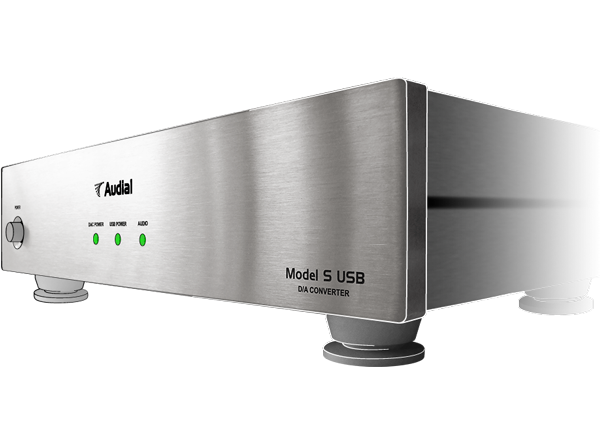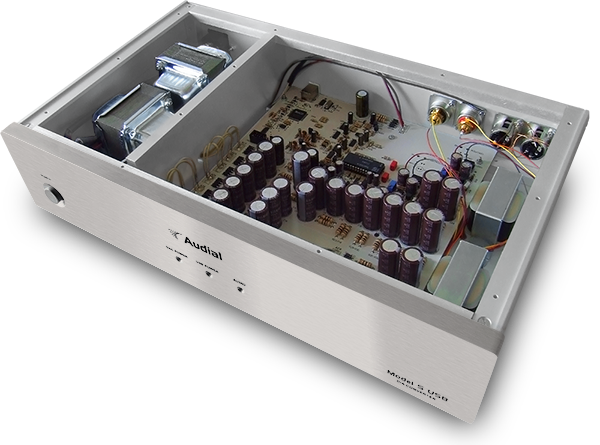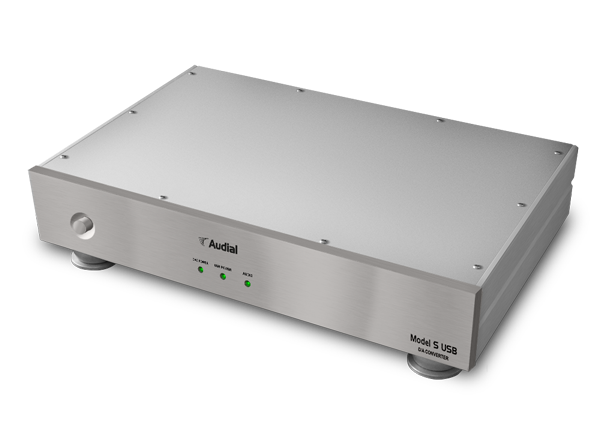Model S USB:
TDA1541A non-oversampling DAC
goes 192 kHz asynchronous USB
Model S USB is the highest class USB D/A converter, the one able to provide real audiophile quality, and natural audio playback from a PC.
Apart from using an asynchronous USB interface, it generally retains its elder S/PDIF Model S brother’s no compromise, state-of-the-art topology and solutions. Still, the Model S USB also brings several changes.
• Asynchronous USB operation, with high-class discrete crystal oscillators next to DAC as master clocks – no PLL inside
• USB front end digitally isolated from the rest of the unit, thus isolating host PC noise from the audio circuits
• Up to 192 kHz compatibility
• TDA1541A D/A converter chip, with externally clocked DEM circuit, and operating in simultaneous data mode (instead of commonly used I2S), for the ultimate jitter performance
• Proprietary transimpedance hybrid output stage, with zero feedback yet with top-level performance (0.002% THD)
• Transformer coupled output (optional)
• Separately housed EI mains transformers
• Isolating mains transformer with split secondary (“balanced AC power”)
• Nine independent supply lines, with multi stage common mode filtering, and zero feedback low noise regulators
• A highest quality parts
• Engraved massive aluminum chassis
• Each sample of the Model S USB is accompanied by its own lab report.
Asynchronous USB interface
The Model S USB operates as an asynchronous USB device, which means that it is a master device that controls the data flow from the host PC. This way the master clock is located inside the DAC, where it controls the D/A conversion directly, removing the jitter problems associated with the host computer and USB interface. Actually, two clocks are needed, one (11.2896 MHz) for 44.1/88.2/176.4 kHz, and another one (12.288 MHz) for 48/96/192 kHz sampling frequencies. And two quality discrete clocks are used, with their own, separate and low noise supply, so the Model S USB achieves the ultimate in jitter performance.
In addition, the USB input stage of the Model S USB is digitally isolated from the rest of the DAC, so the host PC, with associated noise and possible ground loop, is isolated from the clock and downstream audio circuits.
The graph below shows the general scheme of the Model S USB. (Click on the picture to view at full resolution.)

USB class 2.0 audio device
The Model S USB operates as a USB class 2.0 audio device, and it works with sampling frequencies up to 192 kHz.
A driver for Windows XP / Vista / 7 is provided. This driver also includes ASIO support.
Mac OS X 10.6.3 (and above) is officially compliant with USB class definitions 2.0 for audio devices, so the Model S USB doesn’t require a special driver to work with Mac. In practice it works with OS X 10.5.8 as well.
TDA1541A D/A chip with synchronously clocked DEM circuit, and operated in simultaneous data mode
Just as S/PDIF Model S DAC, the Model S USB also uses a venerable TDA1541A chip.
Two Audial Model S DACs are the world’s only DACs that employ an advanced external clocking scheme for the internal TDA1541A DEM circuit.
In addition, the TDA1541A in the Model S USB operates in simultaneous data mode. This mode doesn’t only make TDA1541A more conveniently compatible with up to 192 kHz sampling frequencies, but it also notably improves on TDA1541A jitter performance, in comparison to its I2S mode of operation. As a result, the intrinsic jitter performance of TDA1541A is not a limiting factor in the Model S USB. More information on simultaneous data mode can be found here.
Non oversampling
The Model S USB doesn’t employ oversampling of any kind, whether a classic one, or asynchronous sample rate conversion (a.k.a. up-sampling).
Please however note that the Model S USB can accept sampling rates up to 192 kHz, so any time you find such kind of processing advantageous for CD Red Book sources, it can be performed by PC, and sent as that downstream to the DAC.
No feedback
Just as S/PDIF Model S, the Model S USB is also generally feedback free device. All the top level performance is achieved by adequate circuit designing. Thus the Model S USB THD is 0.002%. The output impedance of transformer coupled output is less than 90 Ohm, whereas the output impedance without the output transformer at the signal path is 3 Ohm.
Power supply, layout & parts
Again, just as its S/PDIF predecessor, the Model S USB employs no compromise PSU concept, with completely separate supply sections feeding each part of the device. Nine PSU sections are used, each having Schottky rectifiers, followed by multiple common mode passive RC filters, and low noise zero feedback regulators. Such a scheme makes also possible a no compromise layout, with supply paths clearly separated from signal / return paths.
The Model S USB also follows the Model S approach for having inside an isolation transformers, which feeds the main transformer by “balanced AC power”. Audial thus won’t direct you to buy additional devices for mains filtering.
Please also note that with the Model S USB Audial moves from toroidal to the classic EI transformers, with primary and secondary windings located at different sections, for their better controlled frequency response. Their somewhat higher external dissipation is here solved by the use of external transformers shields, and separate transformers chamber inside the chassis.
The Model S USB is finally tweaked by careful selection of high quality parts, for their actual sonic properties, so it gives its best as a whole.
Output coupling: transformers vs. capacitors vs. direct coupling
The Model S USB normally has two sets of outputs. Balanced (XLR) outputs can be only transformers coupled. Single end (RCA) outputs can be either transformers or capacitors coupled. It is also possible to order a unit with directly coupled RCA outputs.
Generally, it is possible to order a unit with any given combination of outputs. It is also possible to order a unit without output transformers (which lowers the price), however please note that such a unit can have only RCA outputs.
For further technical information on analog outputs coupling options, please refer to the dedicated topic, page 5 of the Model S USB User Manual, or send your questions via the contact form.
Input:
USB 2.0
Supports 2.0 Class Definitions for Audio Devices
Asynchronous operation
Sampling Frequency:
Up to 192kHz
Outputs:
Unbalanced (RCA) – transformer or capacitively coupled,
and balanced (XLR) – transformer coupled;
2V RMS both
Output Impedance:
Transformer coupled output: 90 Ohm (20Hz – 20kHz)
Capacitively coupled output: 4 Ohm (@ 10kHz)
Frequency Response:
Sin(x)/x equivalent:
@ fS=44.1kHz: 0dB @ 20Hz, -3.2dB @ 20kHz
@ fS=88.2kHz: 0dB @ 20Hz, -0.8dB @ 20kHz
@ fS=192kHz: 0dB @ 20Hz, -0.2dB @ 20kHz
Absolute Phase:
Correct
Transient Response:(*)
Transient response is clean and damped, with no overshoot
Harmonic Distortion:(*)
0.002% @ 1kHz, 50% full scale (-6dBFS)
0.01% @ 1kHz, 10% full scale (-20dBFS)
0.8% @ 1kHz, 0.1% full scale (-60dBFS)
Intermodulation Distortion (CCIR):(*)
0.01%
Mains voltage:
220-240VAC / 50-60Hz, IEC (C14) connector
110-120VAC / 50-60Hz also available
Dimensions (W x D x H):
431.5 x 260 x 118 mm
Net Weight:
Approx. 10 kg
Notice: Since Model S and Model S USB employ the same output stage, the graphs are the same as those published on the Model S page.
Windows USB drivers download requires login with the customer account.



